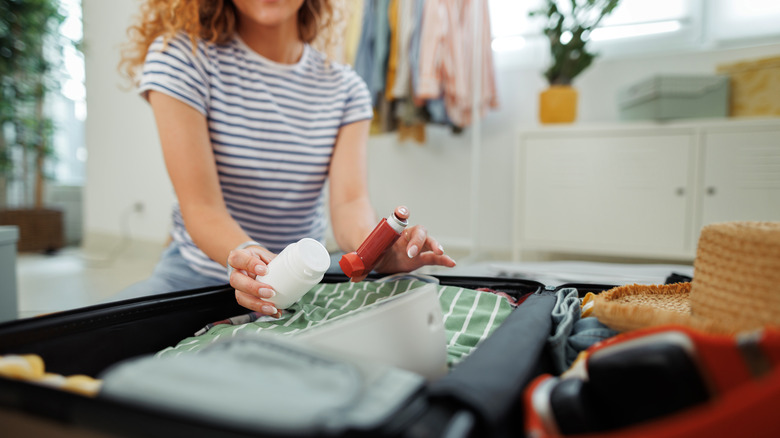The Best Way To Pack Your Medicines For A Flight
Are you one of those people who packs medication loosely in a Ziploc bag when traveling? Maybe you want to save space or protect your privacy, but it can lead to issues. While you might be able to keep track of them by sight, that doesn't mean that you won't make a mistake. Then there is the problem of whether or not you can even take even some common medicines on an international trip, as they may not be legal in your destination. There is a proper way to pack medications, and it can really affect your trip in some instances. You should be packing your medications in the original containers, with the prescriptions, a possible doctor's note, and make sure they're in your carry-on bag in case your luggage doesn't arrive when you do.
There is more to it, however, and you likely have questions. How do you find out if your medication is legal where you're going? What do you do if you won't have enough for the length of your vacation? How can you fly with more than 3.4-ounces of liquid medication when you're not checking a bag? We'll make sense of the rules for you so you can have a great vacation without worrying whether you'll have access to what you need to stay healthy while you're away from home.
What to do about your medications before your trip
It's easy to be confused about flying with medications, and you may even have a prescription that isn't legal in every country, so, as you're making international travel plans, it's a good idea to check with the embassy of the country you're traveling to. Some countries will let you bring a 30-day supply, but only if you have a prescription and/or a medical certificate from your doctor. Fortunately, the U.S. government offers a list of embassy information so you can contact them for their individual rules. You can also check the International Narcotics Control Board for a list of countries and what they allow — do note that some countries haven't provided information.
It's a good idea to see your doctor about a month before you leave so you can get all the necessary documents and supply of medication in time for your trip. If you find that your medication isn't allowed in your destination country, that gives you time to talk about alternative treatments if there are any, and to get any letters from your doctor discussing your condition and treatment plan where needed. If you're going to be away for more than 30 days, ask how you can get medication after that as some insurance companies won't give you more than that at one time. You should also check in about dosages if you're crossing time zones, and how to store the medicine in the first place.
Packing and taking your medications through TSA
Once you have the information you need, it's time to pack. Again, pack medication in your carry-on bag in case your luggage gets lost or arrives late. Always pack it (even over-the-counter) in its original packaging with a legible label, too. Take pictures of the bottles/labels, as well as the prescription and any doctor's notes and put them in a dedicated photo album in your phone. It's a good idea to email them to yourself as well, in case your phone is lost or the battery dies.
One thing to note is that, if you have medication that is in liquid form, it is exempt from the 311 liquid rule in what the Transportation Security Administration (TSA) calls "reasonable amounts." You don't have to pack it in a clear plastic bag, either. However, you must present it to the TSA agent before your screening begins. The usual way is to X-ray it, but you can request a visual screening before it goes through the tunnel. You may be subject to additional security measures which could include opening the item. You are also allowed to bring products like ice packs to keep it cold if necessary, but they must be screened as well. If you have medication accessories like ice packs, or syringes, put them all in a separate tray from the rest of your luggage.


